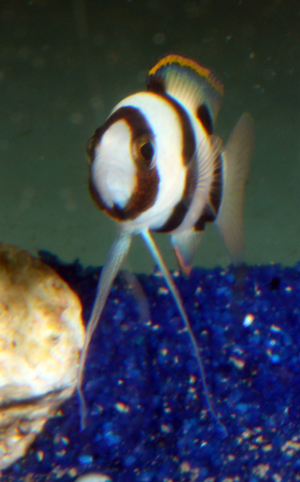Country Critter’s pet shop in Patchogue, NY has landed a specimen of the rare, deepwater basslet Lipogramma evides. This small reef fish from the tropical Atlantic and Caribbean is normally found at depths of 145-365m (480-1200ft)! Collecting fishes at these depths requires the use of mixed gas diving or submersibles and a decompression period of several days, which accounts for their rarity in the trade as well as their impressive price tag. Although we’ve seen this fish on reefbuilders in recent months when it showed up at a Japanese dealer, it’s likely that this banded basslet is currently the only one in the United States.
At first glance, L. evides may just appear to be a black and white banded fish with a rather mundane body shape, but it’s the subtle beauty of its iridescent highlights and its exceptionally long, tapered pelvic fins that make this basslet so appealing…well, that and the fact than none of your friends have one.
This L. evides was obtained through Forrest Young at Dynasty Marine in Marathon Florida and was originally collected at a deep-water collecting station in Curacao. I asked shop owner, Jonathan Hale how much he thought he would get for this fish. He said it’s for sale for $2000, but that he’s happy to just keep on display at Country Critter’s so that crazed fish collectors can stop by to get a look at it. Naturally, I also told him that if he gets another one, we should collaborate on a breeding project. He was very receptive to the idea.
I would like to point out that, in a generous display of their commitment to the future and sustainability of our hobby, Forrest Young and Jonathan Hale donated all of the Liopropoma carmabi that currently make up the broodstock for my Liopropoma breeding project at the Long Island Aquarium. Stay tuned to reefs.com for more updates on aquaculture of bass, basslets and other marine fishes.













Sorry..IMO it should have been left down there.
Do you feel this way about all fish collected for the hobby? If not, I’m curious why this is any different?
I’m going to guess roc5288 said that because it’s rare. We don’t know about their population status being that it’s a deepwater fish. In theory, this could be the last one.
“Rare” doesn’t mean endangered in the hobby. Diving at depths of 480-1200ft is extremely dangerous and that alone makes this fish rare. Collecting fish like these make a lot of sense, especially when they get into hands of people like Todd Gardner. Imagine how much more we can learn about it if he or other breeder would success in breeding this fish…
Actually, what I meant by “rare” is rare in the tropical fish trade. They are, in fact, not uncommon within their depth range, which incidentally, isn’t very deep by world ocean standards (most of the area of the world’s oceans is more than 4000 meters deep). They just live at depths which are difficult to access with SCUBA gear. They have been collected in scientific sampling gear for more than 30 years and are also quite widespread within the Caribbean and Western Atlantic. The difference between the hundreds or thousands that have been captured in deep-sea fishing gear since their discovery and the 3 or 4 individuals taken for the aquarium trade each year, is that the ones for the aquarium trade make it to the surface alive, and can be observed in aquaria…alive. There is a tremendous amount about the biology of an organism that can only be learned from living individuals. Count this among the many contributions of the aquarium hobby to the field of biology and to humanity’s understanding and appreciation of marine life. I think that pretty much sums up the purpose of this forum.